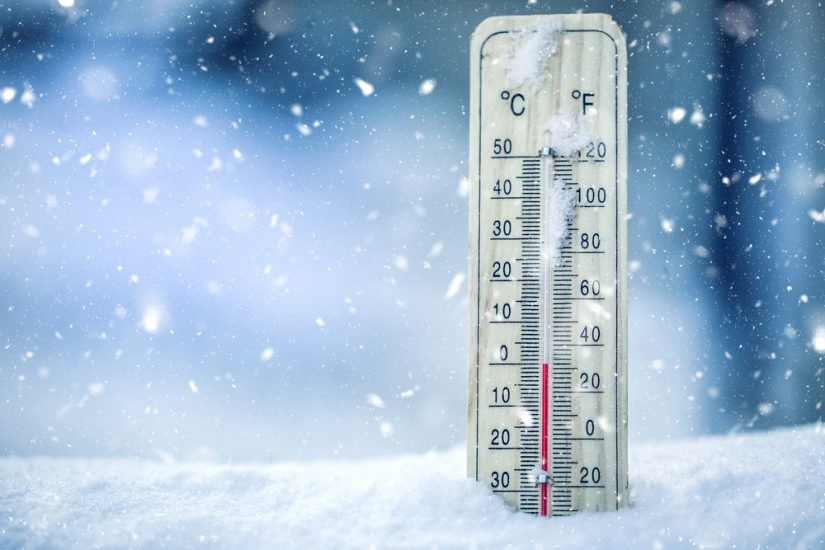In the dog days of summer, we get frequent reminders to hydrate often, but what about winter? The air we breathe in colder weather is drier, so our lungs have to work overtime to add humidity and warm it up. And the more the body works, the more hydration it needs.
No matter the season, a healthy body loses between three to six liters of water every day. The water vapor we exhale alone can fill more than a one-liter soda bottle. So it goes without saying that ensuring workers are sufficiently hydrated is an important step to maintaining a safe, healthy workplace all year round.

Takeaway: Dehydration is a risk even in the dead of winter.
Why Hydration Matters
Our bodies are about 60 percent water. It’s an essential nutrient, allowing us to function at optimal performance levels by:
- Regulating core body temperature
- Carrying nutrients to vital organs
- Flushing internal toxins from the body
We all lose some of this water throughout the day through normal activities like sweating (including between skin and winter clothing), exhaling, urinating, diuretic intake, and natural body exertion to maintain the core temperature (like shivering).
But maintaining proper fluid levels is critical for our bodies to function at full capacity. Without enough fluids, our bodies start to go into dehydration mode. Depending on the severity of the dehydration, this could have a significant impact on the ability to work and function properly.
Winter Dehydration
Dehydration isn’t just caused by sweating under the summer sun. A number of factors can contribute to unsafe body temperature drops and fluid loss in winter weather:
- Freezing temperatures and wind chill
- Improper clothing for the weather
- Physical exertion
- Direct exposure to harsh weather
- Lack of fluid intake and poor diet
- Pre-existing medical conditions
- Poor physical conditioning
Check out this video to learn more about cold stress and hydration:
Are You Properly Hydrated?
Knowing the importance of hydration is one thing; ensuring it is another. That’s why it’s critical for workers to understand how to gauge their hydration level and what steps to take to maintain body fluids.
You can’t always rely on the thirsty feeling to remind you that your body needs more fluids. One of the easiest ways to tell if your body is properly hydrated is by a quick examination of your urine color.
- Pale and plentiful = proper hydration
- Medium to dark yellow = mild dehydration, more fluids required
- Medium to dark orange = severe dehydration, contact a physician
(learn more about : How does dehydration Impact workplace Safety)
Additional symptoms of dehydration include:
- Thirst (though not always)
- Fatigue
- Muscle cramps
- Nausea
- Dizziness
- Confusion
- Excessive perspiration
- Hot and dry skin
In general, it’s recommended that the average adult drink one quart per hour of active work, distributing the intake over a period of time. For example, getting into the habit of drinking about 1 cup (250 ml) of fluid every 15 minutes will keep your hydration levels up for the duration of your shift.
It’s important to understand, though, that everybody is different and the required amount of hydration varies depending on several factors:
- Underlying health conditions – People dealing with high blood pressure, diabetes, and heart disease may have different hydration requirements and certain medications can change the way the body responds to environmental factors.
- Level of physical exertion – Performing basic tasks (even if it’s just breathing) causes the body to lose hydration. The harder the task, the more fluid your body will lose.
- Work environment – In cold weather, sweat tends to turn to water vapor quickly and extra clothing layers can prevent us from realizing we are getting dehydrated. This is one of the main causes of hypothermia in people who remain outdoors for long periods of time.
Making Winter Hydration a Workplace Priority
As important as it is for individual workers to take responsibility for their health, there are ways for managers to make the workplace a hydration-friendly environment.
Provide Education and Training
Basic education is one of the key ways of ensuring that your employees stay adequately hydrated.
Most people know the body requires more hydration when it’s hot outside, but many will be surprised to find out that it’s also a big deal in cold weather. Offering quick, informative training sessions can have a big impact on prevention and preparedness, minimizing the risk of dehydration-related illness.
Have Fluids Readily Available
Workers may be more likely to take hydration breaks when they have drinks easily accessible to them. Employers can help by providing water and warm drinks during the winter. Electrolyte replacement drinks can help replenish depleted electrolytes like sodium and potassium and offer a bit of an energy boost.
Drinks that are warm or at room temperature are better at maintaining the body’s internal temperature and they’re a better choice than cold drinks while working in colder temperatures.
Since caffeine actually dehydrates the body, it’s a good idea to stay away from coffee stations at winter worksites.
Enforce Regular Breaks
Each worksite should have a shelter (ideally a heated one) where workers can get relief from the chilly weather. It’s also a great place to keep water and warm drinks.
Mandating regular breaks is a great way to remind workers to stop and re-hydrate before returning to the job.
Conclusion
Hydration (and dehydration) is an all-season issue. Our bodies lose substantial amounts of water every day and failing to replace these fluids can lead to ill effects like impaired performance – or worse.
Educating workers about proper hydration and providing hydration stations at winter worksites are simple steps any employer can take to ensure employees maintain safe fluid levels throughout the day. By making hydration a habit all through the year, both employers and employees will be rewarded with a healthier workplace.



